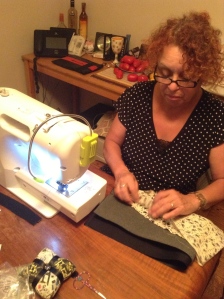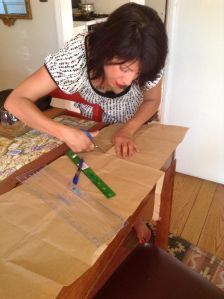When I first started teaching 1984 in 2004, I was thirty-five and still fresh out of graduate school. Standing in front of a summer class of students shivering in their shorts, t-shirts and flip flops while the air conditioned blasted frigid air all around the room at a temperature designed to cool men in three piece suits, I asked the students about Winston Smith’s age.
“How old is Winston Smith?” I was holding a dry erase marker in the air, ready to write the correct answer on the board.
A couple of students shifted in their seats, some looked down at their books, avoiding eye-contact.
“Winston is described at length in Chapter One,” I remind them, hoping their brains hadn’t frozen over.
A blonde guy in one of the middle rows raised his hand.
“He’s really old,” he said, and the all the others around him nodded.
Now, students always find it alarming when teachers laugh out loud because they always think the teacher is laughing at them, but I didn’t know that yet, and I let out a loud, hearty laugh, the kind that I’m known for by friends.
“Really, old?” I said, once I recovered. “How old is really old?” I held up the book to remind them that it was in the book where they could find the answer.
About half of the class, looked down at their books, the high school student taking a college class in summer furrowed her brow in real concentration as she flipped the pages of Chapter one.“Thirty-nine,” the high school student said, raising her hand.
“That’s right; Winston is thirty-nine. Is that old?”
“Well, he seems old,” another student said. “He can barely walk up stairs and his face is all rough and …” The student looks down at his book.
“Sanguine,” I say. “It means like blood red. Maybe he has those red marks that old people get on their skin. I have some of those.”
“How old are you, Ms. G?” asked the student who called Winston old.
“I am thirty-five,” I say, looking right at the student. He was no more than eighteen or nineteen.
“Thirty-five, I didn’t know you were that old!”
The smart high school student jerked her head up from her book to see my reaction.
And again, I laughed, one of those loud laughs where my head goes back and my mouth opens wide.
“Yes, I’m that old,” I say still laughing.
The next time I taught the book, a year older, I warned the students not to call Winston old, knowing that before long, I’d be the same age, and then older like I am now.
I started teaching 1984 in freshman composition because in addition to being a college level writing course, it’s also a course designed to develop critical thinking, which is, really, what the book 1984 is all about. The book also addresses fears about writing. There’s that great moment where Winston faces the blank page of his journal and has no idea what to say, even though the ideas had been roaming around in his head.
For some time he sat gazing stupidly at the paper. It seemed curious that he seemed not merely to have lost the power of expressing himself, but even to have forgotten what it was that he had originally intended to say. For weeks past he had been making ready for this moment, and it had never crossed his mind that anything would be needed except courage. (Orwell 7)
Over the years, students have expressed a similar idea. Most commonly, they report having the ideas in their head where they sound great, but not being able to get the ideas the way they sound in the their heads onto the paper. This of course has to do with the fact that writing is one of the few activities in which both sides of the brain must work together, and doing that takes a lot of practice, and because it’s so hard, it takes a lot of courage too. However, in 1984, once Winston gets going, his ideas begin to form in front of him, showing how the act of writing can help us work out how we feel about things, revealing or helping us form our opinions about things we didn’t know we even had opinions about.
Students like discussing these aspects of the book, but they have over the years got hung up on things that I never expected them to get hung up on or to not find humor in the things I find funny, passages that Orwell wrote for the intention getting people to think and laugh all at the same time.
Until I started warning them against it, it was inevitable for some student to raise his hand and call Julia, Winson’s formerly promiscuous lover, a slut. Now that I teach the book in a higher level English course, a course that teaches logical fallacies, I can point out that such a comment is a double standard fallacy, but back when I was teaching it comp, I had to work hard to explain that one read of the text, that Julia’s sexuality is her rebellion, her response to the oppression she must live under. But after hearing the comment for several years in a row, I heard myself say, “If it wasn’t for girls like Julia, some guys would never get laid.”
This time it wasn’t I who laughed out loud, but an older student, the mom, in fact, of another student in the class; they were taking the class together. She let out one of those little laughs that she choked back, then nodded her head and smiled. Her son, sitting right next to her at the long table in the front of the class, stared straight ahead, maybe hoping that majority of the class still hadn’t figured out that they were related in spite of the fact that they had the same last name.
I continue to teach 1984 for all of it’s important messages, in spite of how dark it is and how depressed it can make some students, but some students might not find it so depressing if they recognized Orwell’s humor. In particular, Orwell likes potty humor or humor about body odor, things that an old lady like me can still appreciate. The punchlines to this humor often comes at the expense of Parson, or characters like him who are stupid or don’t care to think deeply about anything, like in this description:
He was a fattish but active man of paralysing stupidity, a mass of imbecile enthusiasms — one of those completely unquestioning, devoted drudges on whom, more even than on the Thought Police, the stability of the Party depended. At thirty- five he had just been unwillingly evicted from the Youth League, and before graduating into the Youth League he had managed to stay on in the Spies for a year beyond the statutory age. At the Ministry he was employed in some subordinate post for which intelligence was not required, but on the other hand he was a leading figure on the Sports Committee and all the other committees engaged in organizing community hikes, spontaneous demonstrations, savings campaigns, and voluntary activities generally. He would inform you with quiet pride, between whiffs of his pipe, that he had put in an appearance at the Community Centre every evening for the past four years. An overpowering smell of sweat, a sort of unconscious testimony to the strenuousness of his life, followed him about wherever he went, and even remained behind him after he had gone. (Orwell 22)
And then there’s the scene in Part Three of the novel, the scene in the Ministry of Love when Parsons is arrested for thoughtcrime and is in the same cell as Winston and uses the toilet in the cell “loudly and abundantly” only to find that the toilet does not flush. Some students are too subsumed by the darkness of the situation or the coldness of the novel to find anything funny, even if that’s Orwell’s intention, and others sadly, just don’t read closely, or well enough to get it, but I’ve been told that my enthusiasm for the novel and my youthfulness, in spite of my chronological age, helps them to get it, become better readers, and better critical thinkers in the end, after all, which is a good thing because, while we’ll all get old, we don’t have to wind up like Winston.


